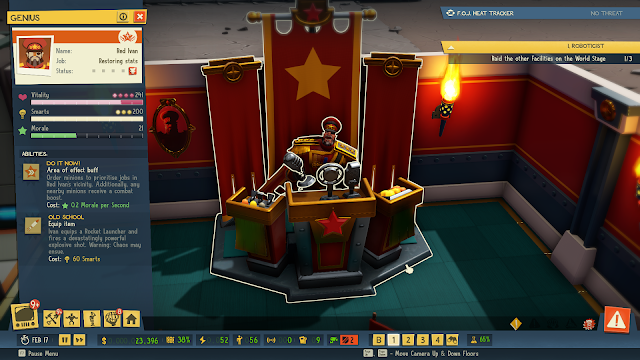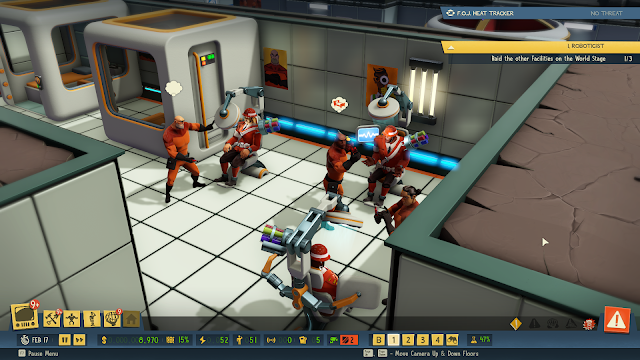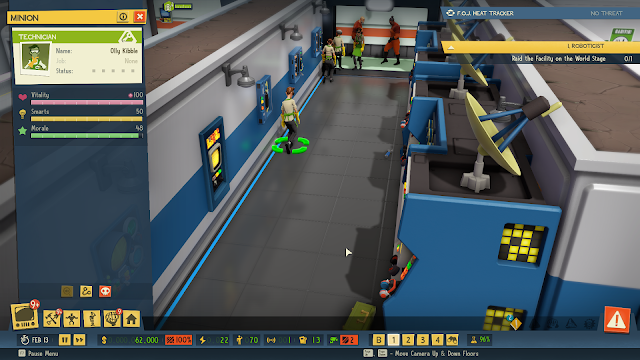Revenge, they say, is a dish best served cold. If that’s true, I’d love to know precisely why my island lair, carefully hidden away from the legally-distinct James Bond clones that seem to keep on want to invading the place, keeps on catching fire. If anything, shouldn’t it be blanketed in snow?
The revenge you’re seeking in Evil Genius 2 has certainly waited a while and had more than a small chance to go a bit on the tepid side.
The original Evil Genius was reasonably regarded in its heyday – and I can recall reviewing it all the way back in 2004, although the vagaries of online publishing mean that my original review is lost in the mists of Internet time – but 17 years is long enough that most are now calling it a “cult classic”, which is the polite way of describing a game that didn’t quite do well enough at the cash registers to warrant a quick sequel. Indeed, I’m a little bemused that it’s back at all, because Evil Genius did rather mine its central conceit for all it was comedically worth.
Evil Genius 2: World Domination is, essentially, more of the same, and in most ways it’s a fair bit better, as you should expect any game that has nearly two decades of tech and game design advantages under its belt should be.
Dr Evil/Blofeld stand-in Maximillian returns as the effective default choice, but you can optionally choose combat-focused Red Ivan (voiced wonderfully in just the right scenery-chewing ways by Brian Blessed), science-centric Zalika or Spymistress Emma as your genius of choice. Each of them has particular strengths that can seriously adjust how you approach the game’s management style, as well as their own world domination goals within the game’s campaign mode.
Anyone who’s played any of the other more comically-centric management sims – I’m thinking here of games such as 2 Point Hospital more recently, or classics such as Dungeon Keeper or Theme Hospital – will dive into the base building segment of Evil Genius 2 with relish, and it’s easily the game’s strong point.
You’ve got the usual careful resource balancing that you’d expect of any game of this type, having to keep your minions at least basically happy (or cowering in terror if you choose to execute a few as an example to the others) as you build out your base, work your way up the game’s complex tech tree and make your moves on the global stage to that domination that your crazed fiend – sorry, I mean Evil Genius – so dearly craves.
It’s on the world stage that Evil Genius 2: World Domination rather falters. Each area is broken up into zones. Each zone needs to first be scouted, after which you can then send minions out to perform robberies, distractions to get the heat off you or run critical side story and main campaign missions. I adored the writing around these missions, which hit some great comic notes, but not the technical reality of actually doing them.
They’re all a bit samey, and you just end up selecting whatever’s available when it’s available to you, and then waiting while the animations play out. While there’s an in-game tutorial available to you from the start, it’s a rather wide open game, and that can mean you select objectives that really only delay you from what you’d rather be doing later in the mid and late-game stages, because once you’ve started on an objective path (which itself may have many sub-objectives to burn through) there’s no going back.
All too often, I found myself waiting for specific things to happen, whether it was for flights to send minions off to gather more loot, or for enemy agents to appear so I could capture them and gain precious intel to enable further campaign missions on the world map… which meant I was back waiting for minions and flights to make this all happen!
The game does feature a fast-forward feature to remove some of the waiting time, but that’s a risky play in itself, especially later in the game when more challenging agents are likely to infiltrate your base, steal your gold or set just about everything on fire.
This also isn’t helped by the fact that Evil Genius is sometimes bogged down in a lack of explanation, and it’s something that can get rather frustrating. I lost more than a few hours to campaign objectives that were simply oblique in their descriptions, requiring me to click around my base trying to work out how the interactions between objects worked, or where the game really wanted me to go.
I can deal with feeling stupid if I miss an instruction or skip a tutorial, but not so much when there’s in-game elements that could really use a comprehensive in-game manual to go along with them!
It is a tricky balance, because there’s a certain joy in these games in discovering just what devices can do – especially when it comes to the more advanced traps that can work quite well in sequence for some truly Bond-level spy elimination malarkey – but not when it appears that either the developers were too familiar already with what they wanted, or simply didn’t think that some players might like a little more guidance from time to time.
When Evil Genius 2 gets it right, it gets it spectacularly right, and if you’re the type that can bury your brain into resource management while laughing at the deliberately cliched and over-the-top style of the game, you’ll have plenty of moments of fun taking over the world, one carved-out-of-mountain-rock room at at time. However, there’s still some rough edges here, and some game balancing that could have made it even more engaging, both for those who adore resource management and those who might just like the challenge of taking over the world with the help of a few shiny new doomsday devices.
– Alex Kidman
Contributor













